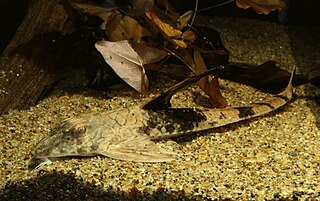
Loricariidae is the largest family of catfish, with over 90 genera and just over 680 species. Loricariids originate from freshwater habitats of Costa Rica, Panama, and tropical and subtropical South America. These fish are noted for the bony plates covering their bodies and their suckermouths. Several genera are sold as "plecos", notably the suckermouth catfish, Hypostomus plecostomus, and are popular as aquarium fish.

Hypostomus is a genus of catfish in the family Loricariidae. They are native to tropical and subtropical South America. H. plecostomus is the popular freshwater aquarium fish formerly known as Plecostomus plecostomus. The taxonomic structure of the Loricariidae is still being expanded by scientists. Hypostomus is a highly species-rich and widely distributed catfish genus.

Chiloglanis is a genus of upside-down catfishes native to Africa. These species have modified lips and barbels that form a suckermouth. They also have a naked (scaleless) body. Sexual dimorphism has been reported in Chiloglanis. The adult males of many of these species have elongate anal and caudal fins. Also, males may have an enlarged humeral process.

Microsynodontis is a genus of upside-down catfishes native to freshwater rivers in western Africa. The genus was originally described by British-Belgian zoologist George Albert Boulenger in 1903 based upon the type species Microsynodontis batesii. The name microsynodontis comes from the Greek word mikro, meaning small, and the Greek term synodon, meaning "with the teeth all growing together".

Chiloglanis batesii is a species of upside-down catfish found widely in Western and Central Africa. This species grows to a length of 4.7 centimetres (1.9 in) TL.
Microsynodontis armatus is a species of upside-down catfish endemic to Gabon where it occurs in the Ivindo River. It was first described in 2004 by Ng Heok Hee.
Microsynodontis emarginata is a species of upside-down catfish endemic to Gabon where it occurs in the Ogowe River. It was first described in 2004 by Ng Heok Hee.
Microsynodontis hirsuta is a species of upside-down catfish endemic to Gabon where it occurs in the Ntem River. It was first described in 2004 by Ng Heok Hee.
Microsynodontis laevigata is a species of upside-down catfish endemic to Gabon where it is found in the Ivindo River. It was first described in 2004 by Ng Heok Hee.
Microsynodontis nannoculus is a species of upside-down catfish endemic to Equatorial Guinea where it occurs in the Kyé River. It was first described in 2004 by Ng Heok Hee.
Microsynodontis nasutus is a species of upside-down catfish endemic to Gabon where it occurs in the Ogowe River. It was first described in 2004 by Ng Heok Hee.
Microsynodontis notata is a species of upside-down catfish endemic to Gabon where it occurs in the Ogowe River. It was first described in 2004 by Ng Heok Hee.
Microsynodontis vigilis is a species of upside-down catfish endemic to Gabon where it occurs in the Ogowe River. It was first described in 2004 by Ng Heok Hee.

Synodontis filamentosus, known as the longfin synodontis, is a species of upside-down catfish that is native to the basins of the Nile, Volta and Niger Rivers as well as the Chad Basin. It was first described by British-Belgian zoologist George Albert Boulenger in 1901, from specimens obtained near the mouth of Lake No, on the White Nile in Sudan. The species name filamentosus comes from the elongated rays of the dorsal and caudal fins.

Synodontis ocellifer, known as the ocellated synodontis, is a species of upside-down catfish native to the rivers of northern and western Africa. It has been reported in 10 countries, including Burkina Faso, Cameroon, Chad, Gambia, Ghana, Guinea, Mali, Niger, Nigeria, and Senegal. It was first described by Belgian-British zoologist George Albert Boulenger in 1900, from specimens collected in Kunchow Creek, in Gambia. The species name ocellifer comes from the Latin word ocellus, meaning "eye", and the Latin word ifer, meaning "to carry", which refers to the black spots, possibly with white centers found on the sides.
Chiloglanis kazumbei is a species of upside-down catfish found in Tanzania, where it occurs in the lower Malagarasi River and the Luiche River; it has also been seen in affluents of Malagarazi in Burundi. This species grows to a length of 5.4 centimetres (2.1 in) SL.
Chiloglanis igamba is a species of upside-down catfish that occurs in Tanzania's Malagarasi River, to which it is probably endemic. This species grows to a length of 6.5 centimetres (2.6 in) SL.
Chiloglanis orthodontus is a species of upside-down catfish that occurs in several greatly separated sites in the lower Malagarasi River in Tanzania, and is likely endemic to the basin. This species grows to a length of 2.9 centimetres (1.1 in) SL.
Chiloglanis fortuitus is a species of catfish native to West Africa, specifically rivers in Liberia. It was first described in 2023, alongside another species of Chiloglanis, Chiloglanis frodobagginsi.
Chiloglanis devosi is a species of catfish native to Africa, in particularly rivers in Kenya. The species was first described in 2015, alongside Chiloglanis kerioensis. It was named after Luc De Vos, who had served as the director of the Ichthyology Section of the National Museums of Kenya.






